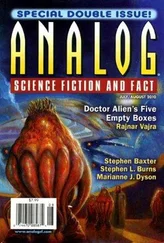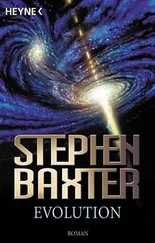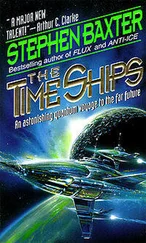That’s why I agreed to appear in this infomercial. Support Reid Malenfant. If you can’t bring yourself to do that, get off his back. The man is out there risking his hide for you and your
children.
Give him a break.
Emma Stoney:
Malenfant started up the life-support systems. Pumps and fans clattered into life, and Emma felt a breeze, flat and warm, in her hair. Then Malenfant clambered back up to the zero G deck to check the ship’s comms systems and navigation alignment.
The others gathered on the ops deck and stripped off their fat orange pressure suits. They changed into lightweight NASA-type jumpsuits that lacked a lot in style but were warm and practical and covered in pockets and Velcro strips. They shoved the pressure suits down the hole into the Earth-return capsule and dogged closed the hatch.
Michael had to be manhandled through all this. He was passive, unresponsive, like a week-old infant; it was possible to move him around, even strip and clean and dress him like a doll, but he seemed to have no will of his own. Emma let Michael stay on the ops deck, and made sure at least one of them was there with him the whole time.
She realized that she had a sneaking, selfish gratitude that Michael was aboard. Having someone else to think about would take her mind off her own utter disorientation.
She climbed the fireman’s-pole ladder to go up — or down — to the module’s other two compartments. The disorientation of the changing vertical wasn’t so bad if she spent a few seconds in the zero G bay giving herself time to adapt. Then she could put out of her mind the fact that the ops deck had just been down; now it was up, and the ladder down now led her to the other decks that used to be above her head.
It worked fine provided she didn’t look up through the mesh and see people dangling from the ceiling like chandeliers.
The bio sciences deck was a mix of lab and field hospital. There was some medical equipment: a collection of pills and lotions and bandages and inflatable splints, and more heavy-duty equipment, scary-looking stuff like a defibrillator. The small lab area was pretty much automated, with little requirement from the crew but to pump in regular samples of blood and urine. Everything was color coded and labeled and built into smart little plastic units you could just pop out of the wall to repair and replace.
The lowest deck — called, with nerdish humor, the meatware deck — was up against the outer bulkhead of the craft, and so was the farthest from the cluster’s center of gravity. They would eat and sleep here, under the strongest gravity available — about equivalent to the Moon, a sixth of Earth normal. It wasn’t exactly possible to walk normally here, but at least she could move around without getting a kick sideways the whole time.
There was exercise gear: foldaway treadmills and an exercise cycle. Bunks were neatly stacked against one wall. They had private curtains, zip-up sleeping bags, night-lights, and little personal stowage pockets. She looked inside one of the pockets and found a small softbook and music player with headset, a sleeping mask, and earplugs, all marked with Bootstrap logos. It was cute, like an airline giveaway pack.
The John — strictly speaking the Waste Management System — looked like it would be less fun. It was the old space shuttle design, a lavatorial veteran of decades of spaceflight. There was a commode with an operating handle and, God help her, a control panel. Liquid waste would be captured and pumped away for recycling. Solid waste wasn’t recycled; a valve would open to the vacuum of space to dry out the feces, and it would then be dumped overboard. When she turned the handle a vent opened and air started sucking its way down into the commode, big vanes turning in a very intimidating way.
The toilet could only be used four times an hour, she noted with apprehension. She suspected that in the early days at least they would need more capacity than that.
Each crew member had a personal hygiene kit, more airline-complimentary stuff: a toothbrush, toothpaste, dental floss, nail clippers, soap, a comb, a brush, antichap lipstick, skin lotion, stick deodorant, a tube of shaving cream and a shaver that, bizarrely, worked by clockwork. There was a little hand-washing station, a hole in the wall through which you thrust your hands, and jets of hot and cold water played over your skin. It was also, thankfully, possible to take a shower, with a hose and a nozzle that you passed over your body inside a concertina-type wraparound curtain. But the curtain was imprinted with stern instructions about the importance of washing down the shower properly after use, to
avoid algal growths.
The galley was a neat little unit the size of a domestic freezer. It had hot and cold water dispensers, serving trays, a range of plastic plates and cutlery, and a teeny-tiny microwave oven. On the door of the galley was a complete food list, everything from apple sauce to turkey tetrazzini. The food, stowed under the galley, came in dehydrated packages, sliced meats with sauce or gravy in foil packages, plastic cans with tear-off lids. There were also a few treat items like candy bars in, the labels said, “their natural form.” There was even a tap that would dispense Shit Cola, the relic of some long-forgotten sponsorship deal. Experimentally she found a cup, a globe with an inlet valve and nipple, and tried a little of the Shit. The carbonation didn’t seem to be working right — no doubt some low-gravity problem — and it tasted lousy.
There was enough food for the four of them for two hundred days in space: ninety days out, ninety back, twenty at the asteroid. No doubt that could be stretched by rationing if it came to it, but it did give a finality to the mission duration.
She was unstowing all of this from its launch configuration when Malenfant called her from the zero G deck. She glanced at her watch and was startled to find that already twelve hours had elapsed since the launch.
She pulled herself up the ladder to join Malenfant by a window. He grinned and took her arm. “You’ll want to see this. We’re here for a gravity assist. In fact, we’ll be doing this twice.”
Quietly, he talked about the difficulty of reaching Cruithne, with its highly elliptical and tilted-up orbit. To that end the impulse from the rocket stack would be boosted with gravity slingshots around the Moon. The ship would whip right around the Moon, to be hurled inward past the Earth, and then out past the Moon a second time. The theft of momentum by the O ‘Neill would mean that the Moon would forever circle the Earth a fraction slower.
She let his words wash over her. For, beyond the small, curving window, she saw black, gray, brown-white, a mesh of curves and inky darkness, sliding across her view like oil. It was a crescent bathed in sunlight, pocked with craters, wrinkled by hills. On the plains she could see boulders, pinpoints of brightness sending long, needle-fine shadows across the dusty ground. And the cres cent was growing. The ship was flying into the shadow of the
Moon toward the terminator, the line between night and day.
The sunlit crescent narrowed, even as it spread across space. It was soon too large to be captured by a single window, and she leaned forward to see the sweep of the Moon, from horn to skinny horn. At last the crescent narrowed to invisibility, and she was flying over the shadowed Moon, a hole in the stars.
She found she was holding her breath. The noises of the ship’s systems, little gadgets humming and ticking, seemed sacrilegious in this huge dark quiet.
There was an explosion of light. She craned to see.
Far ahead of the craft, the sun was rising over the Moon. A line of fire had straddled the horizon, poking through the mountains and crater rims there. The light fled across the bare surface, casting shadows hundreds of miles long from mountains and broken crater walls. The smaller, younger craters were wells of darkness in the flat light.
Читать дальше
Конец ознакомительного отрывка
Купить книгу












